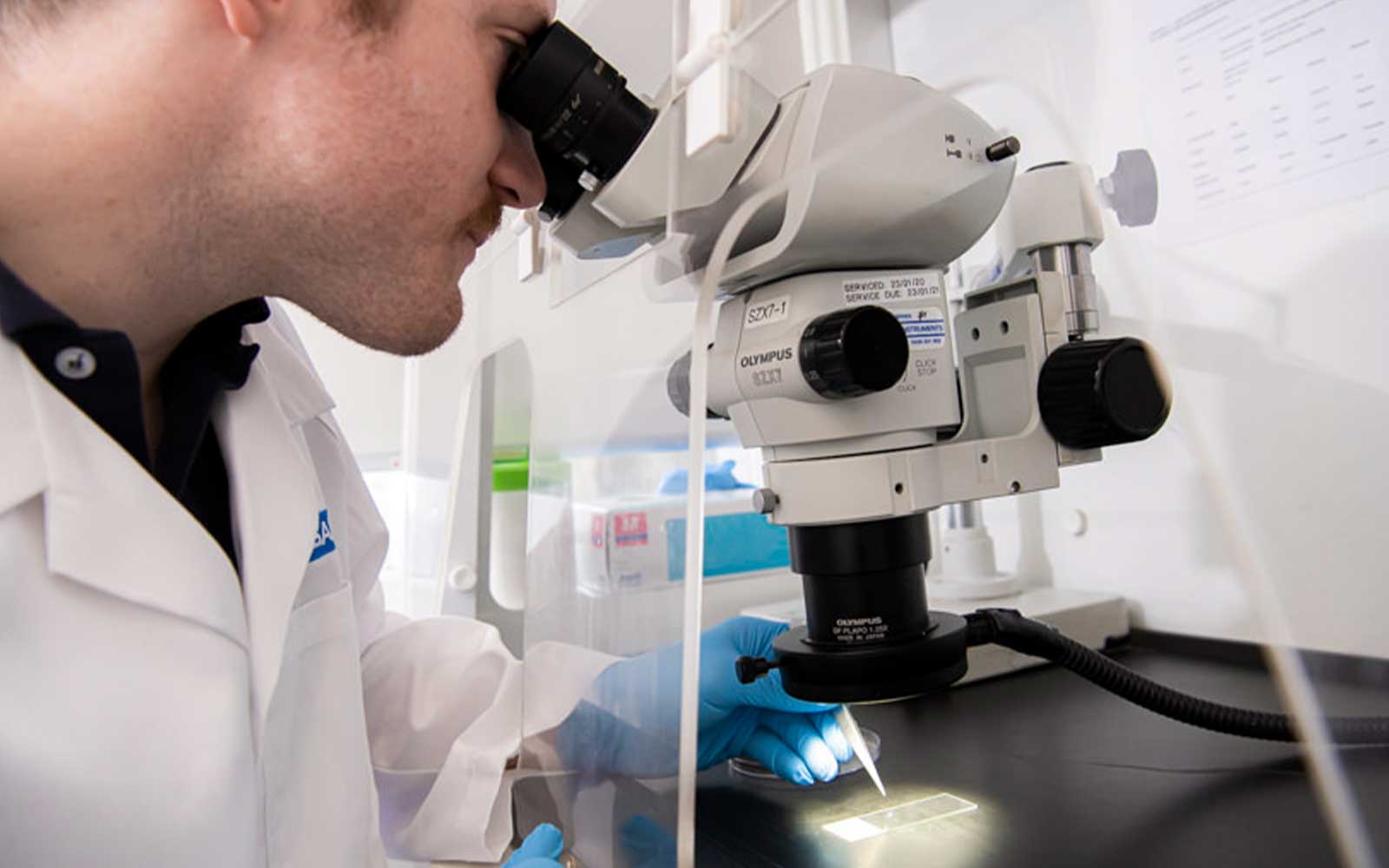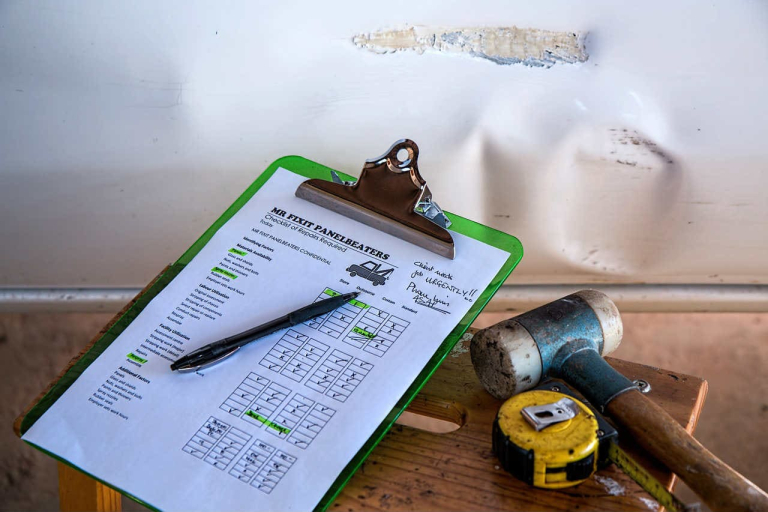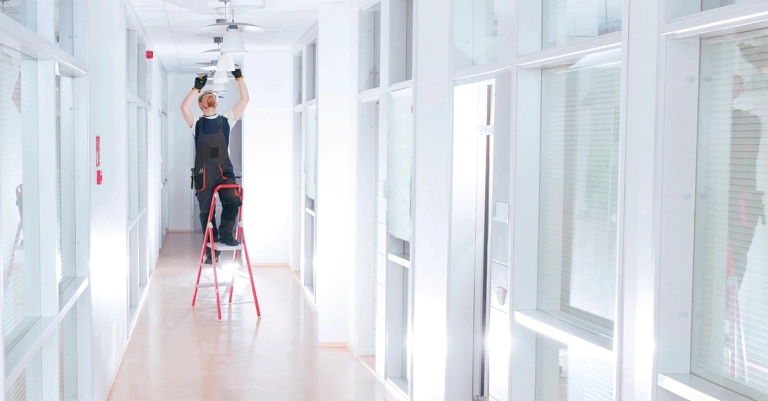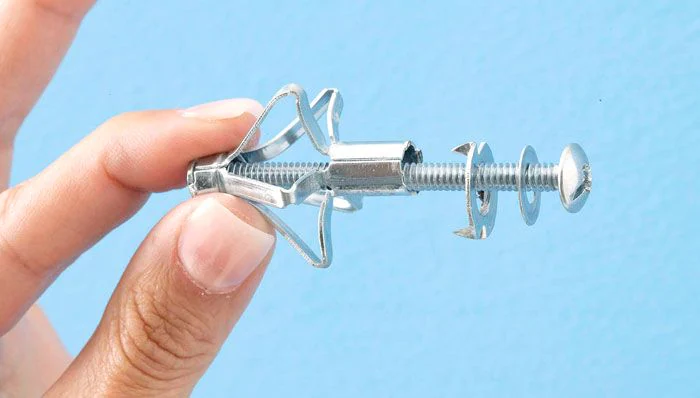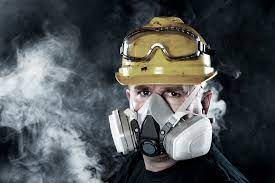Testing for Asbestos
1. Polarised Light Microscopy (PLM)
Polarised Light Microscopy uses a special microscope to create polarised light conditions in which asbestos fibres become visible.
Regular light microscopes use unpolarised, white light. This is the type of light that we see with the naked eye, and its waves vibrate in random directions. Polarised light, however, has waves that vibrate only in one direction, and cannot normally be seen by human beings. The chemical composition of asbestos means that its fibres behave in a certain way under polarised light, making it possible for a trained technician to identify a material as asbestos, rather than another material that might look similar to the naked eye.
2. Dispersion Staining (DS)
Dispersion Staining is an analytical technique that takes advantage of the differences in the dispersion curve of the refractive index of an unknown material, relative to a standard material with a known dispersion curve, to identify or characterize that unknown material.
In asbestos testing, Dispersion Staining is used alongside Polarised Light Microscopy to confirm the presence of asbestos fibres in a sample, and to identify the specific type of asbestos.
You should always be careful when taking samples of materials that you suspect may contain asbestos. Here’s our easy step-by-step guide:
-
- Take safety precautions as outlined in Fact Sheet 2: Safe Practices for Homeowners Repairing or Removing Small Amounts of Asbestos Materials from asbestosawareness.com.au (or see some below)
- Wet the material to suppress dust release.
- Carefully collect a sample using hand tools (sample size should be 5-100g).
- Place the sample in a click lock plastic bag. You can find these at any supermarket.
- Clean your hand tools thoroughly with a wet wipe then seal the wipe in its own click lock bag.
- Double bag your sample in a second sealable plastic bag.
- After sampling, you should use paint to seal any broken material with the potential to cause airborne asbestos dust.
- If you can’t bring your sample in person, call us to make other arrangements.
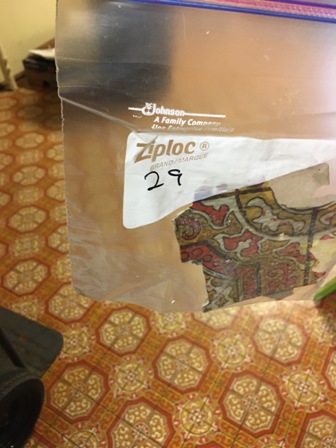
If your house was built before 1990, it is quite likely that it will contain some form of material containing asbestos. If you are unsure whether your house contains asbestos materials, it is better to treat any suspect material as though it does contain asbestos.
We strongly suggest that you have your home assessed for asbestos containing materials and tested (if required) prior to undertaking any general maintenance, renovation or demolition activities.
Asbestos is a naturally formed mineral silicate material, the fibres of which when liberated are an inhalation health hazard.
Since December 31st 2003, asbestos and all products containing asbestos have been banned throughout Australia. It is illegal to import, store, supply, sell, install, use or re-use these materials. The ban does not apply to asbestos containing materials installed prior to this date (e.g. asbestos in houses). Asbestos can remain “in situ” – however if disturbed e.g. during renovations, or in poor condition, it must be removed.
Asbestos has not been used in domestic building materials since the late 1980s. Cellulose fibres are now used instead of asbestos in building materials and non- asbestos fibres, such as glass, are now used in insulation products.
Testing for asbestos isn’t as easy as just looking at the material to see if it contains asbestos. The presence of asbestos in a building material can only be confirmed by laboratory testing to the Australian Standard AS 4964. Testing involves using a stereo microscope to identify fibres and then a Polarising Light Microscope (PLM).
The results of this testing will identify whether the material contains Chrysotile (white asbestos), Amosite (brown asbestos) or Crocidolite (blue asbestos), or whether there is no asbestos in the material. It is important to note that the results of asbestos testing only determines if asbestos is present, it does not provide a risk assessment – this can only be undertaken by a competent person e.g. an asbestos consultant.
The asbestos testing laboratory you choose to use must be accredited by NATA (National Association of Testing Authorities). Most state and commonwealth legislation specifies that a report be done by an accredited laboratory. This ensures that the laboratory is the highest quality and that the report can be relied upon. For information on testing and accredited laboratories in your area, visit nata.com.au or call 1800 621 666.
Fact Sheet
It’s recommended that removal of asbestos materials is performed by a licenced
asbestos removalist. However, when renovating or doing maintenance around
the home, homeowners may come across what they suspect are asbestoscontaining materials.
If a small amount of non-friable (bonded) asbestos is found, homeowners may
wish to remove and dispose of it safely or repair minor damage to a wall of
asbestos sheeting (fibro).
Accidents can happen. Sometimes an asbestos sheet or other asbestos-containing
products can be damaged, broken or may be unsealed so it is important to seal all
asbestos materials including any breaks or cracks to prevent the release of fibres.
• SEAL broken or damaged asbestos with quality paint. While some paints
specifically designed to seal asbestos are available, as long as you use a good
quality paint to cover the exposed area, the asbestos material will be sealed.
• CHECK the area from time to time to ensure the paint is still in good
condition and recoat when required.
WORKING SAFELY WITH SMALL AMOUNTS
OF ASBESTOS AROUND THE HOME
DON’T CUT IT!
DON’T DRILL IT!
DON’T DROP IT!
DON’T SAND IT!
DON’T SAW IT!
DON’T SCRAPE IT!
DON’T SCRUB IT!
INTERNAL FLAKING PAINT
EXTERNAL PEELING PAINT
EXPOSED TO WEATHER
PEELING PAINT, EAVES,
GUTTERING AND DOWNPIPE
EXTERNAL PEELING PAINT
EXTERNAL: WELL PAINTED AND SEALED INTERNAL: WELL PAINTED AND SEALED
BROKEN ASBESTOS CEMENT SHEETING
UNSEALED AND BROKEN SHEETING
DON’T DISMANTLE IT!
DON’T TIP IT!
DON’T WATERBLAST IT!
DON’T DEMOLISH IT!
AND WHATEVER YOU DO…
DON’T DUMP IT!
HAZARDS
MANAGING ASBESTOS HAZARDS AROUND THE HOME
When managing asbestos you must minimise the risk of releasing fibres that
can become airborne. To ensure you protect yourself, your family and those
around you (including neighbours and pets) from exposure to potentially
dangerous fibres when removing small amounts of asbestos, there are some
basic safety rules you must follow.
SAFETY CHECKLIST
Asbestos fibres can be harmful to health so when it comes to asbestos be sure
to remember;
DO’S
PLAN your job in advance so you have all the
necessary equipment on hand.
WEAR Personal Protective Equipment (PPE) at all
times.
ENSURE no electrical wiring or electrical products
are in the work area.
PREPARE your equipment and work area before
you start.
ONLY wear old clothes under the coveralls. These
should be disposed of when the job is completed.
COVER removal area in 200um plastic drop sheets to
catch any fibres, dust and debris.
WET the area that contains asbestos using a gentle
mist spray of water before commencement. Detergent
added to the water helps improve absorption or a mix
of 1 part PVA glue to 5 parts water will help bond the
material to minimise any dust.
CONTINUE wetting asbestos that is exposed – If you
can see it, wet it!
SPRAY using a spray bottle to wet smaller areas.
LOW-PRESSURE constant spray mist using a
garden hose with a mist nozzle can be used to wet
larger areas outdoors such as external walls or fences.
MINIMISE the number of people in the work area.
DECONTAMINATE yourself, the work area and
equipment when work is completed.
FOLLOW THESE DO’S & DON’TS
TO ENSURE you and YOUR FAMILY ARE SAFE
DON’Ts
NEVER CREATE dust.
NEVER BREAK asbestos sheeting.
NEVER WORK in windy conditions.
NEVER USE POWER TOOLS OR EQUIPMENT
that can produce dust.
NEVER USE BROOMS OR BRUSHES except for
sealing if using paint or a PVA glue solution.
NEVER USE HIGH PRESSURE water spray on ANY
asbestos product including walls, fences and roofing.
NEVER USE HOUSEHOLD VACUUM CLEANERS.
Only special H Class Asbestos vacuum cleaners are
used by licenced removalists to collect dry asbestos
dust and debris.
DON’T KNOW HOW TO IDENTIFY ASBESTOS-CONTAINING MATERIALS?
Visit asbestosawareness.com.au to view our online video, Asbestos In Your Home – The Ultimate
Renovators Guide and search the Asbestos Products Database for examples of what to look for!
ASBESTOS PERSONAL PROTECTIVE EQUIPMENT (PPE)
FOR HOMEOWNERS
The purpose of wearing PPE when working with asbestos is to create a barrier between you and the fibres. There should be no tears
or breaks in any PPE products. Remember, if products (such as coveralls) are damaged or torn, fibres can get in so any damaged or
perished PPE must NOT be used and must be disposed of.
1. SUITABLE PPE is made from materials that protect you and your clothes from fibres including coveralls, gloves, safety
footwear, shoe covers, gloves and protective eyewear.
2. DISPOSABLE PPE can be used ONLY ONCE then must be disposed of safely just like any asbestos waste (see page 6).
3. IF YOU KNOW your home contains asbestos, have an Asbestos PPE Kit and sealing paint on hand should it be required
to make emergency repairs or seal asbestos safely if it becomes damaged.
WARNING
NEVER WORK ON DRY OR FRIABLE ASBESTOS.
FOR AREAS THAT CAN’T BE WET DOWN PRIOR
TO REMOVAL, ENGAGE A LICENCED ASBESTOS
REMOVALIST.
DO NOT WET ANY AREA THAT MAY CONTAIN
ELECTRICAL WIRING OR EQUIPMENT THAT
MAY BE CONNECTED TO ELECTRICITY SUCH AS
HOUSEHOLD GOODS (FRIDGES), TOOLS ETC.

